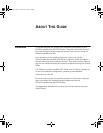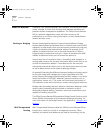
Document Notation
3
Table 2 Text Convention
Document Notation
References to specific OfficeConnect Remote 840 Manager pages in this
document will use a specific notation to describe the location of a page
relative to the OfficeConnect Remote 840 Manager home page. The
notation uses the' >' character to indicate that a sub-menu on a page
must be accessed.
For example, to monitor the IP ARP Table you would (starting from the
home page) access the Monitor menu. From the Monitor menu you
would access the Networks sub-menu. From the Networks sub-menu you
Convention Description
Screen displays
This typeface represents information as it appears on the
screen.
Syntax
The word “syntax” means that you must evaluate the syntax
provided and then supply the appropriate values for the
placeholders that appear in angle brackets. Example:
To add a login user, use the following syntax:
Add user <name> password <password>
In this example, you must supply a user name for <name>
and a password for <password>.
Commands
The word “command” means that you must enter the
command exactly as shown and then press Return or Enter.
Commands appear in bold. Example:
To view the current login users, use the command:
list users
The words “enter”
and “type”
When you see the word “enter” in this guide, you must type
something, and then press Return or Enter. Do not press
Return or Enter when an instruction simply says “type.”
Keyboard key names If you must press two or more keys simultaneously, the key
names are linked with a plus sign (+). Example:
Press Ctrl+Alt+Del
Words in
italics
Italics are used to:
■
Emphasize a point.
■
Denote a new term at the place where it is defined in the
text.
■
Identify menu names, menu commands, and software
button names. Examples:
From the
Help
menu, select
Contents
.
Click
OK
.
840ug.book Page 3 Friday, July 7, 2000 2:23 PM


















